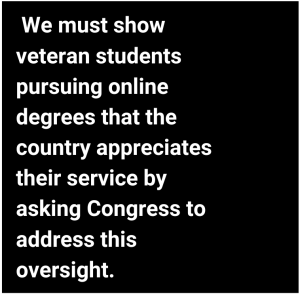Update the GI Bill for the Online Era
Published by: WCET | 11/21/2022
Tags: Military And Veterans, Online Learning, Tuition And Fees
Published by: WCET | 11/21/2022
Tags: Military And Veterans, Online Learning, Tuition And Fees
We normally do not repost content from other sources, but today’s Frontiers entry is a notable exception. November brings us in the United States two great holidays focused on giving thanks. This week is Thanksgiving, but we also are very thankful to the sacrifices made by armed service veterans who strived to protect our freedoms. I am the grateful son of a 32-year Air Force vet. We have not talked much lately about the inequities that veterans face in receiving a reduced housing allowance if they enroll in courses that are completely online. Read these student stories. It is an archaic notion.
Thank you to former WCET Steering Committee Chair, Shannon Riggs of Oregon State University, recently wrote this opinion piece asking for a change in the policy. We agree. Veterans deserve our thanks, and they deserve better.
– Russ Poulin, Executive Director, WCET

Each year, more than 700,000 veterans rely on the GI Bill to pay for their education, but those who pursue online degrees don’t receive their benefits in full. We must show veteran students pursuing online degrees that the country appreciates their service by asking Congress to address this oversight.
GI Bill benefits include a monthly housing allowance based on the college’s zip code. Students are allotted more funding in cities and towns where housing is more expensive, and less where housing is less costly. When veterans pursue degrees online, however, the housing allowance is reduced to half the national average, regardless of location or housing costs.
At Oregon State University, where I serve as the executive director of our Ecampus, the 493 veteran students who pursued their degrees online full-time with us in 2021 faced a shortage of $871.50 per month. (The shortage for part-time students is pro-rated, so a student taking three classes instead of four per semester would receive 80 percent of the housing allowance).

If the GI Bill was set up this way under the assumption that online students have more flexibility, more ability to work and less financial need, our university data shows otherwise. At Oregon State, distance students actually have greater financial need: 44 percent of our online students are eligible for Pell Grants, as compared to 25 percent of our on-campus students.
Further, students who need to balance work and school—a primary reason students pursue degrees online—aren’t eligible for as many financial aid resources as full-time students.
The quality of online degree programs has increased substantially since the GI Bill law was updated in 2008. As early as 2010, an authoritative U.S. Department of Education report showed “no significant difference” in learning outcomes between online and in-person courses. More recently, a 2019 study confirmed that online learning is as effective as face-to-face education in the classroom. Many education scholars believe that course design, faculty and class size are more important factors than whether college students are learning remotely or not.

Statistics from the National Center for Education highlight steady growth in student enrollment in online courses, with the COVID-19 pandemic accelerating that growth. More college students are adult learners choosing online degree programs to stay at their jobs and avoid relocating their families. Withholding half the housing allowance for online courses doesn’t make sense because, whether attending on campus or not, veteran students still have housing expenses.
The rationale behind the GI Bill was to help veterans transition from military service to civilian life. By all accounts, it has been highly successful in the more than seventy-five years since it was signed into law. The GI Bill more than doubled the number of college graduates in the United States while helping to educate millions of veterans.
But, unfortunately, it has fallen behind the times. Online education is here to stay, and lawmakers should update the GI Bill accordingly.
Associate Vice Provost of Educational Programs and Learning Innovation, Oregon State University
This column was produced by Progressive Perspectives, which is run by The Progressive magazine and distributed by Tribune News Service. The post is captured here in its entirety and the original article can be found here.